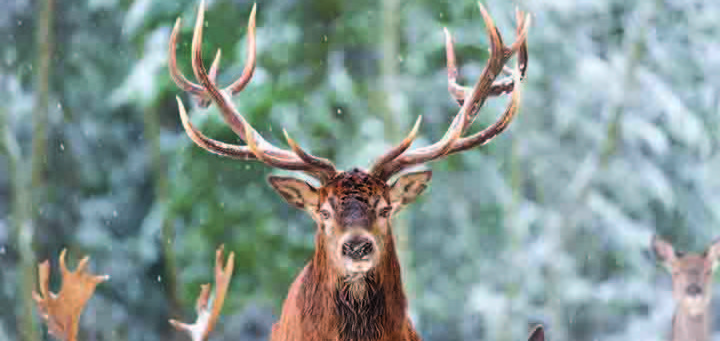
Conversations
Local Wildlife: How local wildlife is reacting to urban sprawl and what to do about it
November, 2019
When Lucas Wilfred Finnamore-Smith lived in the Spruce Grove area, there was a burrow of foxes just past the tracks. He, and others, admired their cuteness from a respectful distance.
“Every spring the little kits would come out and romp around right outside the den,” he recalls. “I’d stop my bike when riding into town to watch them across the road. Once in a while cars would do the same.”
Furry creatures can seem adorable from a distance, but at the same time, wild animals definitely need their wiles to survive. Wildlife can pose hazards in urban areas, when they wander in hungry and curious. Well-meaning humans may try to feed them and get too close, which can cause more harm than good in the long run. As we become even more urbanized, the problem of how we can coexist with our animal neighbours is a complex one that defies easy solutions, and may even end up changing how we design our cities.
Bright Lights, Big City
During this past summer there were a number of isolated wild animal sightings in communities surrounding Edmonton including bears, cougars, and even moose. One Spruce Grove couple’s backyard bird feeder was destroyed by a bear.
The pace of urban growth in central Alberta is a big reason why human-wildlife encounters occur as often as they do. Through good economic times and bad, Edmonton and its surrounding communities have exploded in size. Since the 1991 census, Spruce Grove has experienced annual double-digit growth rates that have occasionally topped 30 percent.
The building of roads, buildings and neighbourhoods, as well as agricultural development, has put a great deal of pressure on wildlife, however. Animals generally don’t stick around in just one place; rather, they tend to move between natural areas in search of shelter and food, often using the cover of night or vegetation to remain hidden. Urban environments interfere with this by eating up natural areas and breaking up wildlife corridors. They can also pose a direct threat to wildlife—human-wildlife conflicts are much more likely to end badly for the animal, and obstacles like major roadways pose lethal hazards for animals simply trying to get from one place to another.
“Wildlife live and travel within our community,” says Spruce Grove District Fish and Wildlife Officer Andy Nestorovich. “Spruce Grove area has large green spaces that can support that. While most encounters are positive and people appreciate seeing wildlife around, it is important to take precautions to reduce the risks associated with wildlife in semi-urban and acreage settings.”
Two Worlds Colliding
Fortunately, it’s an issue that city officials and planners in the region are increasingly aware of. As Spruce Grove is located in the Low Boreal Mixed Wood Ecological Area, it is a natural habitat for many species of birds and animals. However, most wild animals will avoid direct contact with humans, but can sometimes make their presence known in the city through the parks and trail system, or because people have made their way into the animals’ natural habitat. The City’s main advice is not to approach or attempt to handle wildlife.
While the loss of natural cover is one factor
bringing wildlife out under the glow of streetlights, another is the sheer
amount of food that cities offer. Coyotes are a good example. Adaptable and
intelligent, they’re masters at living on the fringes of city life. As
omnivores that’ll eat almost anything, their varied diets include fruit and
berries, small mammals and food scraps left behind—intentionally or
otherwise—by people. If you haven’t noticed, these are all food sources readily available in or near
urban centres.
“Alberta towns and cities have developed rapidly and many urban areas have expanded into what was, until recently, natural wildlife habitat,” says Fish and Wildlife Officer Dennis Prodan, who is with the Edmonton district office, which handles calls concerning large wildlife. “Many animals, such as coyotes, foxes, and magpies, have readily adapted to life in the city. Coyotes, for instance, are opportunistic and readily adapt to their surroundings. Many communities in Alberta have a great deal of green space that is perfect for wildlife.”
Creatures Great and Small
Tove Reece, Executive Director with animal rights organization Voice for Animals, also blames urban sprawl on the increase of wildlife in cities. “Animals are being squeezed out of their natural homes,” he says.
“It should not come as a surprise that they are looking for space wherever they can find it, even in busy, dangerous and often hostile cities. I think it’s important to remember that wildlife has not come into the city to attack anyone or to cause trouble but simply looking for food and a place to survive. Most wild animals are not dangerous and would rather avoid people than have an encounter or confrontation.”
In the Capital Region, large wildlife can include moose, deer, coyote, cougar, and lynx, but can depend upon the season and breeding time. However, most wild animals will avoid direct contact with humans, but can sometimes make their presence known in the city through the parks and trail system, or because people have made their way into the animals’ natural habitat. The main advice from experts is avoid approaching or handling wildlife.
A general rule is the larger the animal, the larger the risk. “Moose pose a higher level of risk to the public than most other species,” says Prodan. “A moose that is stressed, a bull moose in the fall rut, or a cow moose protecting her young may be easily provoked into an attack, which is a risk to individual and public safety. A motor vehicle collision with a large ungulate can also be serious. Any large predator should be respected and given their space. When stressed, startled, or threatened they may become defensive or aggressive.” t7x
Lower the Risk
“The best thing to do to avoid conflicts with wildlife is prevention,” says Fish and Wildlife Officer Dennis Prodan. “Make your property unappealing to wildlife and manage any attractants on your property.” Here is some of his practical advice for anyone concerned about coming into contact with urban wildlife and keeping critters away from their homes.
Never feed wildlife. Wildlife feeding on food from people and human-use areas not only prevents wildlife from getting nutrition from natural food sources, it teaches wildlife to associate people with food. This can lead to problematic, even dangerous, situations that may result in human injury and/or wildlife being destroyed.
Never approach wildlife. It may be stressful for wildlife when someone enters their territory. Over time, wildlife can become accustomed to people, increasing the risk of negative human-wildlife encounters. Always respect the “personal space” of wildlife to help them stay wild. Also keep in mind that bats, skunks, and foxes are carriers of rabies and, if seen acting oddly, must be avoided, even if your intention is to help.
Keep your dog on a leash. Even well-trained dogs cannot fight their instinct to bark and chase. This can stress wildlife and cause them to dart into traffic or lead to other unsafe situations such as a defensive attack.
Keep your cats indoors. Cats allowed to roam make easy prey for coyotes and foxes. Coyotes and foxes that learn easy prey can be found in a neighbourhood will return to that same area for future meals, creating potential new problems for the community. Keeping cats indoors also helps protect the native songbirds that frequent the city.
Keep your garbage in a secure container with a lid. Make sure your garbage containers are in good condition. Household waste appeals to wildlife as a source of easy meals.
Remove food and shelter that attracts wildlife to your property. Clean your yard of all garbage, pet foods, bird seed, and fallen fruit and berries that can serve as a food source for wildlife. Potential shelter, such as the spaces under decks, patios, and outbuildings, should be closed off with durable wire mesh.
Drive carefully. Slowing down when driving near parks, river valleys, golf courses, and other green spaces lessens the likelihood of collisions with wildlife.
Teach your children about wildlife in the city. Children should be taught to make safe decisions and respect wildlife by never feeding or approaching wildlife, putting garbage into garbage cans, not running away when they see coyotes or foxes, and keeping their pets leashed and supervised.
Alberta Fish and Wildlife (Spruce Grove)
780-960-8190
Northern Alberta Wildlife Rescue & Rehabilitation (WILDNorth)
780-914-4118









